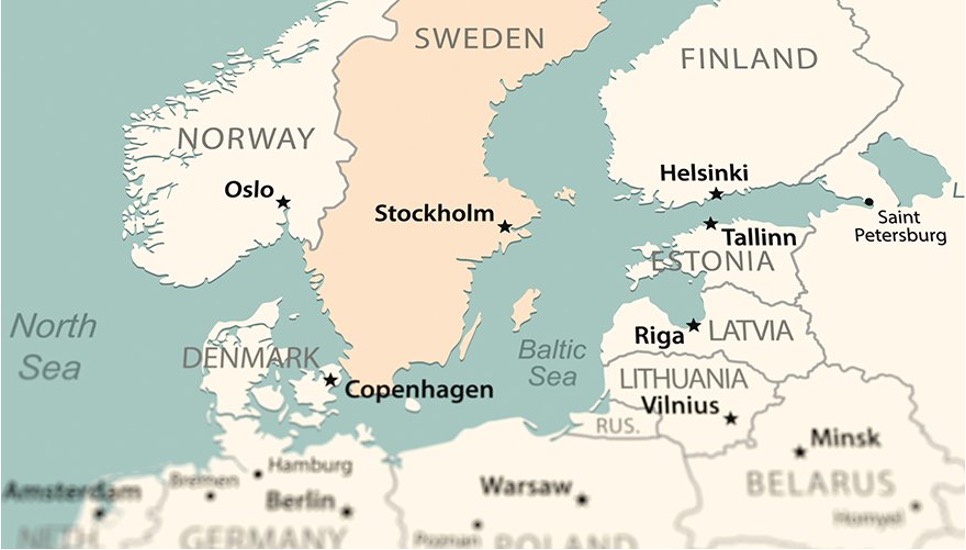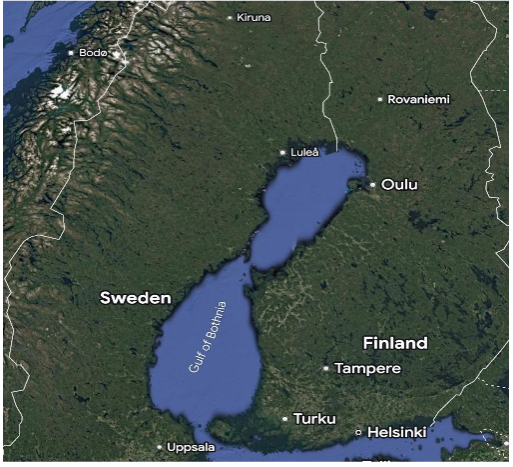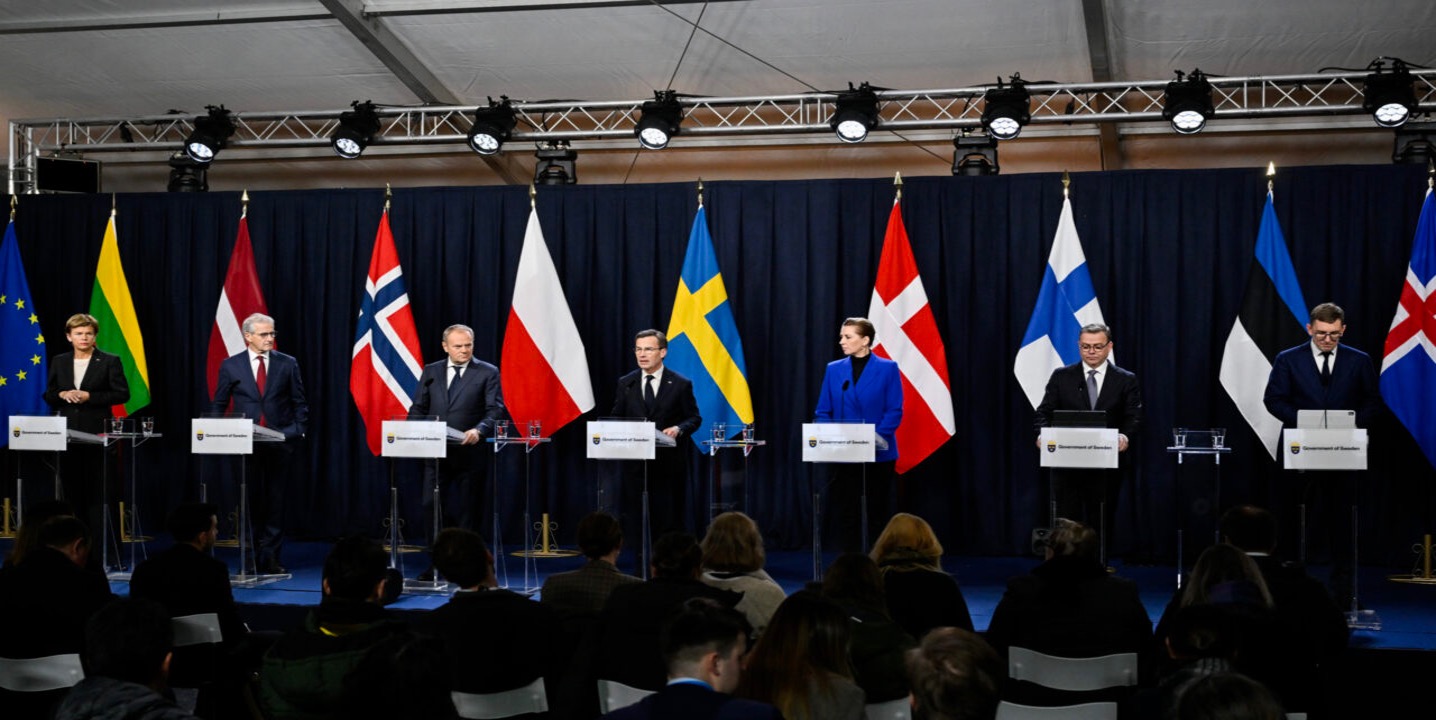The accession of Finland and Sweden to NATO has redrawn Europe’s northern security map. What was once a patchwork of bilateral ties and EU–NATO “plug-ins” is becoming a contiguous defense space from the Arctic to the Suwałki corridor. This analysis maps the emerging Nordic–Baltic architecture, the capability shifts (air, maritime, ISR, cyber), and the strategic effects on Russia’s calculus in the High North and Baltic Sea.
1) Why this matters now
Finland and Sweden’s accession transforms the Northern theatre from “flank” to “front.” The Baltic Sea is nearly a NATO lake; The other Baltic NATO members are Latvia, Estonia, Poland, Germany and Denmark with a ninth ally Norway bordering the sea lanes entering the sea. Russia’s two access points are at St. Petersburg and Kaliningrad — an enclave cut off from Russia by Poland and Lithuania. Arctic security has a stronger allied anchor and the Suwałki corridor—while still a vulnerability—sits within a deeper web of reinforcement routes. The question is no longer whether the Alliance can deter in the North, but how fast it can defend—and sustain defense—under stress.
 https://www.nationaldefensemagazine.org/articles/2024/7/10/baltic-sea-now-called-a-nato-lake
https://www.nationaldefensemagazine.org/articles/2024/7/10/baltic-sea-now-called-a-nato-lake
2) The new map: geography, access, depth

3) Capability shifts (where the delta is real)
Air & Integrated Air and Missile Defense (IAMD)
Finland’s F-35 procurement, Sweden’s upgraded Gripen fleet, and Norway’s existing F-35s create a dense fifth-/4.5-gen mix.
The center of gravity moves toward networked sensors: shared air picture, cross-border QRA hand-offs, and better cueing for ground-based air defenses.
Remaining gap: layered IAMD against cruise and ballistic threats; standardization of GBAD (e.g., NASAMS, IRIS-T SLM, Patriot) and munitions stockpiles.
Maritime & Undersea
The Baltic Sea becomes a contest of shallow-water ASW, mine countermeasures, and protection of seabed critical infrastructure (pipelines, power/data cables).
Sweden’s A26 and Gotland-class subs, Finland’s new corvettes, and allied P-8A patrol aircraft boost detection and denial.
Remaining gap: persistent undersea domain awareness (fixed seabed sensors, autonomous systems) and rapid repair capacity for critical cables/pipes.
The land fight is about speed and sustainment: winterized mobility, pre-positioned stocks, bridging assets, rail gauge compatibility, and fuel distribution under EM-contested conditions.
Nordic land forces emphasize high readiness brigades, territorial defense, and long-range fires (MLRS, precision strike).
Remaining gap: harmonized movement permissions, scalable depots, and resilient cross-border logistics that survive cyber attacks.
Cyber, Space, ISR
The region hosts advanced cyber capacities (public–private) and space-enabled ISR. The critical issue is tasking authority and latency—who fuses what, when, for whom?
4) Russia’s evolving posture in the theatre
Kola priority: Expect Russia to insulate SSBN operations and protect access to the Greenland–Iceland–UK (GIUK) gap.
Hybrid pressure: More cable sabotage risks, GNSS spoofing, cyber probes against energy grids/ports, disinformation aimed at alliance fatigue.
Conventional risk: Lower than pre-2022 due to force attrition in Ukraine, but localized spikes(airspace incursions, missile tests into Baltic approaches) remain plausible tools of coercion.
5) Political frictions to watch
Rulebook gap: National caveats on intel-sharing and the pace of moving from air policing to truly integrated IAMD.
Burden-sharing optics: How costs for seabed protection and stockpile replenishment are split between Nordics, Baltics, Germany, Poland, and the U.S.
EU–NATO interface: Deconflicting roles on infrastructure funding, military mobility, and industrial policy (EDF, ASAP, EDIRPA vs NATO planning).
6) Scenarios (12–24 months)
Best-case: “Integrated Northern Shield”
Key Hypothesis
Nordic–Baltic states operationalize a joint concept of operations: integrated air picture, shared maritime domain awareness, and cross-border logistics drills at scale.
Impact
High deterrence credibility; reduced reaction times; lower risk of miscalculation.
Markets price in lower regional risk; energy and data infra better protected.
Strategy
Field a layered IAMD architecture (Patriot/NASAMS/IRIS-T SLM) with common C2.
Deploy a seabed surveillance grid (fixed sensors + AUVs) and create a Nordic–Baltic Repair Poolfor undersea infrastructure.
Institutionalize quarterly “Arctic Rail & Road” stress tests for military mobility.
Stability-case: “Strong but Siloed”
Key Hypothesis
Capabilities grow, but integration lags; cooperation remains mostly national/bilateral, with patchy data sharing and uneven logistics readiness.
Impact
Deterrence holds against major aggression; resilience to hybrid attacks is uneven.
Higher insurance/energy risk premia persist; political bandwidth is consumed by coordination frictions.
Strategy
Adopt minimum viable interoperability: common data formats, shared SOPs, and munitions-stock goals.
Launch a Nordic–Baltic Cyber Fusion Cell for real-time OT/ICS threat intel to ports, grids, and rail operators.
Use the EU’s military mobility funds to fix 5–7 named chokepoints (bridges, tunnels, ports).
Worst-case: “Patchwork under Pressure”
Key Hypothesis
Hybrid attacks surge (seabed sabotage, cyber on ports/grids, GNSS spoofing). Aerial provocations spike; political disputes slow decisions. One undersea incident disrupts energy/data flows for weeks.
Impact
Economic disruption across the region; shaken investor confidence; contested alliance narratives.
Moscow perceives gaps and probes further below Article 5 thresholds.
Strategy
Pre-agree incident playbooks (attribution thresholds, proportional responses, repair tasking).
Stand up a Seabed Protection Task Force with coast guards, navies, and private cable/energy firms.
Stockpile rapid-repair kits and contract standby commercial vessels for emergency deployments.
7) What success requires (actionable recommendations)
Make IAMD real, not rhetorical
Establish a Northern Air & Missile Defense Operations Cell to fuse air, missile, and UAS tracks with common ROE for cross-border engagements.
Prioritize munition stockpiles and interchangeable launchers; run quarterly live-fire validations.
Own the seabed
Map all critical routes (energy, telecom) with redundancy plans; pre-contract survey/repair operators.
Deploy a layered system: fixed hydrophones, mobile AUVs, and patrol patterns for choke points (Skagerrak, Bornholm, Gotland approaches).
Harden logistics under EM and cyber stress
Winterize supply chains; pre-position fuel/bridging sets; harmonize rail movement rules.
Run black-start drills for ports and depots (operate after power/cyber outages).
Fuse cyber & industrial resilience
Share OT/ICS threat intel between defense and critical-infrastructure operators.
Create a Nordic–Baltic Resilience Fund (public–private) for rapid hardening of ports, grids, and data hubs.
Align politics with the playbook
Pre-agree attribution & response language for hybrid attacks to avoid paralysis.
Use the EU for mobility funding and industry scaling; use NATO for planning, readiness, and C2.
8) Bottom line
Northern enlargement gives NATO unprecedented geographic and operational advantage—but only integration turns this into lasting security. The next 12–24 months are decisive: if allies converge on IAMD, seabed protection, and logistics under stress, the Nordic–Baltic space becomes a model of modern defense. If not, the region risks remaining strong in parts but fragile as a system—exactly the condition hybrid adversaries seek to exploit.
